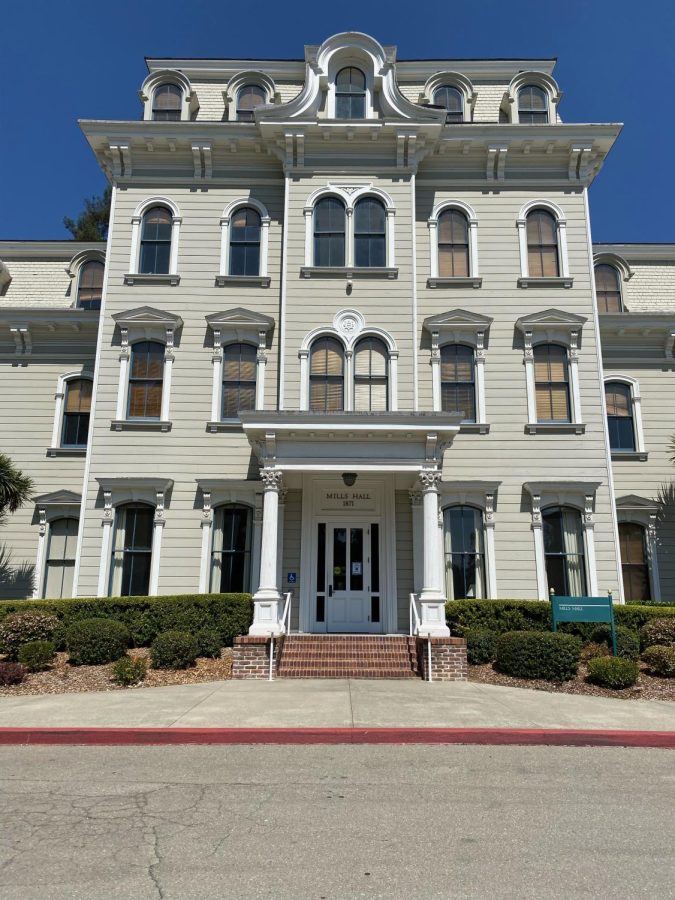Mills College merger creates uncertainty, hope
Mills Hall at Mills College houses the school’s office of the president. The college, the latest addition to Northeastern University’s “global network”, will focus on empowering women, first-generation students and students of color.
October 15, 2021
Northeastern University announced Sept. 14 that it had finalized its merger with Mills College, a women’s college in Oakland, Calif. The agreement will change Mills to a coed institution, rename it to Mills College at Northeastern University, and bring its 135-acre campus into Northeastern’s “global network”, according to a statement by President Joseph E. Aoun.
Established in 1852, Mills is “the oldest women’s college west of the Mississippi,” said Elizabeth Hillman, the president of Mills College.
“That’s an era that’s coming to an end here with this merger with Northeastern, and that’s a loss for our community, and, I hope, a gain for our mission, in order to sustain things going forward,” Hillman said in an interview with The News.
In the past, Mills’ policy has been to admit “self-identified women and people assigned female at birth who do not fit into the gender binary” as undergraduates and all genders as graduate students, per its website.
In 1990, students at Mills College stopped an attempt by the college to become fully coeducational in response to declining enrollment. The merger will establish the Mills Institute which is “dedicated to advancing women’s leadership and to empowering BIPOC and first-generation students.”
“Mills has an extraordinary campus. That makes Mills special, honestly. Mills’ location in California has shaped Mills tremendously,” Hillman said. “Mills was the first women’s college to recognize that gender was more fluid than what women’s colleges have thought in the past and welcomed nonbinary students and trans women to its campus community.”
“I think there are people on both ends of the spectrum, in terms of excited and people who are also disappointed and frustrated. I think most people are in the middle zone,” Cohen said. “Mills is a very special place, and I think that people are worried about losing that.”

In the past year, the Save Mills College Coalition and the Alumnae Association of Mills College, two groups of current Mills students and graduates, sought to challenge the merger in court.
Although the Save Mills College Coalition was not immediately available for comment, its website states that its mission is to “stop the proposed closure of Mills College” and “investigate all appropriate options that could continue it as a degree-granting college, prioritizing options that maintain Mills as a college for women, non-binary, and transgender students with graduate programs for all genders.”
In 2017, Mills declared a financial emergency, preceding rounds of layoffs due to an annual operat- ing deficit that has grown to more than $9 million, with a $57 million operating budget for the following year. In March 2021, Mills College announced it would cease to be a degree-granting institution, but by June, the college had announced it intended to merge with Northeastern.
The merger, finalized Sept. 14, will take full effect July 1, 2022, and Northeastern will assume all of Mills’ financial assets, liability and contractual obligations.
“Mills has been in a challenging financial situation for many years,” said Chicora Martin, the vice president of student life and dean of students at Mills. “When you’re small, you don’t have the economy of scale, and it’s harder. We have a beautiful campus, but it’s a big footprint, a lot of buildings and a lot of maintenance, and so it has been difficult for us to have the kind of experience we want for our students.”
Hillman said the future was still uncertain, but that she was optimistic.
“We don’t know enough yet. Our students don’t know enough about Northeastern to really under- stand everything yet,” Hillman said. “Students trust students more than anybody else to tell them actually how it is, and what things are like, and so I look forward to that chance, for our students to connect and to learn more.”
Referencing Mills’ majority-people-of-color and majority-LGBTQ student population, as well as its high numbers of first-generation students, Martin described Mills as “a space to really think about who you are, and who you want to be, and what’s important to you, and giving you the opportu- nity to do that in a really welcoming environment.”
“I understand some people are optimistic, some people are curious, some people have a little bit of trepidation or anxiety — some people are sad because Mills will change,” Martin said. “I think if we’re thoughtful, if we’re really inclusive, and thinking about the voices of our community, I think that’s the most important thing. I think there will be places where we need to work harder to make sure we’re doing it well, and places where it’ll be just seamless.”







